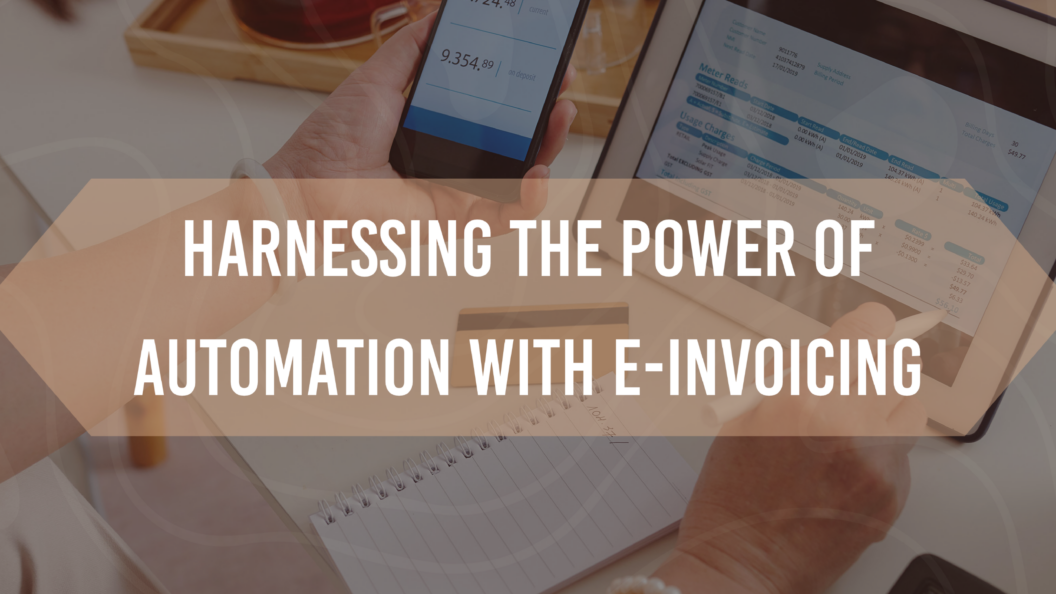Harnessing the Power of Automation with E-Invoicing
Harnessing the Power of Automation with E-Invoicing
Author: GDS
E-invoicing has emerged as a powerful solution for streamlining the invoice process. It eliminates manual labor and errors, making it more efficient and accurate for businesses of all sizes. This blog post will discuss the advantages of e-invoicing, including greater efficiency, fewer mistakes, shorter payment times, and improved cash flow. We’ll also cover the best practices for implementing e-invoicing, such as setting up a workflow and integrating with existing accounting systems. Finally, we’ll provide insights into how companies can take advantage of this advanced technology to optimize their invoicing process and achieve greater financial success.
E-invoicing has emerged as a powerful solution for streamlining the invoice process. It eliminates manual labor and errors, making it more efficient and accurate for businesses of all sizes. This blog post will discuss the advantages of e-invoicing, including greater efficiency, fewer mistakes, shorter payment times, and improved cash flow. We’ll also cover the best practices for implementing e-invoicing, such as setting up a workflow and integrating with existing accounting systems. Finally, we’ll provide insights into how companies can take advantage of this advanced technology to optimize their invoicing process and achieve greater financial success.
What is E-Invoicing?
E-Invoicing, or Electronic Invoicing, is a digital invoicing process that enables organizations to streamline their invoice management processes. By eliminating paper and manual procedures, e-invoicing allows companies to create, send, receive, store, and manage their invoices electronically. E-invoicing offers significant advantages over traditional methods of invoicing, including improved accuracy and reduced cost of processing invoices, as well as increased efficiency and fewer errors. It also helps to reduce costs associated with invoice processing and shorten payment cycles. In today’s digital economy, e-invoicing is becoming increasingly popular among businesses of all sizes.
What is E-Invoicing?
E-Invoicing, or Electronic Invoicing, is a digital invoicing process that enables organizations to streamline their invoice management processes. By eliminating paper and manual procedures, e-invoicing allows companies to create, send, receive, store, and manage their invoices electronically. E-invoicing offers significant advantages over traditional methods of invoicing, including improved accuracy and reduced cost of processing invoices, as well as increased efficiency and fewer errors. It also helps to reduce costs associated with invoice processing and shorten payment cycles. In today’s digital economy, e-invoicing is becoming increasingly popular among businesses of all sizes.
Benefits of E-Invoicing
The advantages of e-invoicing are numerous. Companies that adopt e-invoicing can create, send, receive, store, and manage their invoices electronically, resulting in increased efficiency and significant cost savings. Furthermore, e-invoices can easily be tracked, making it easier for businesses to monitor payments and ensure they are accurately received. Additionally, since e-invoices are digital documents they can be shared across multiple departments and systems, providing increased visibility into the invoice process. Finally, by eliminating manual processes involved with paper invoices, businesses can reduce errors and avoid time-consuming corrections.
– Streamlined invoicing processes, resulting in increased efficiency and cost savings
– Accurate tracking of invoices to ensure they are received accurately
– Increased visibility into the invoice process thanks to digital documents that can be shared across departments and systems
– Reduced errors due to the elimination of manual processes
– Shorter payment cycles
– Reduced costs associated with invoice processing
Benefits of E-Invoicing
The advantages of e-invoicing are numerous. Companies that adopt e-invoicing can create, send, receive, store, and manage their invoices electronically, resulting in increased efficiency and significant cost savings. Furthermore, e-invoices can easily be tracked, making it easier for businesses to monitor payments and ensure they are accurately received. Additionally, since e-invoices are digital documents they can be shared across multiple departments and systems, providing increased visibility into the invoice process. Finally, by eliminating manual processes involved with paper invoices, businesses can reduce errors and avoid time-consuming corrections.
– Streamlined invoicing processes, resulting in increased efficiency and cost savings
– Accurate tracking of invoices to ensure they are received accurately
– Increased visibility into the invoice process thanks to digital documents that can be shared across departments and systems
– Reduced errors due to the elimination of manual processes
– Shorter payment cycles
– Reduced costs associated with invoice processing
Choosing the Right E-Invoicing Solution
Choosing the right e-invoicing solution can be a difficult task, as there are numerous options available. Organizations should consider their specific needs and goals when selecting an e-invoicing solution. For instance, companies may prioritize features such as invoice creation and delivery capabilities, automated payment processing, real-time tracking of invoices and payments, or integration with existing systems. It is important to select an e-invoicing solution that offers the features necessary for businesses to streamline their invoicing process, increase efficiency, and save time and money. Organizations should also consider elements such as cost, scalability, security measures, customer support, and ease of use when selecting an e-invoicing solution. By taking the time to assess their needs and evaluate potential solutions, businesses can ensure they select the best e-invoicing solution for their unique requirements.
Choosing the Right E-Invoicing Solution
Choosing the right e-invoicing solution can be a difficult task, as there are numerous options available. Organizations should consider their specific needs and goals when selecting an e-invoicing solution. For instance, companies may prioritize features such as invoice creation and delivery capabilities, automated payment processing, real-time tracking of invoices and payments, or integration with existing systems. It is important to select an e-invoicing solution that offers the features necessary for businesses to streamline their invoicing process, increase efficiency, and save time and money. Organizations should also consider elements such as cost, scalability, security measures, customer support, and ease of use when selecting an e-invoicing solution. By taking the time to assess their needs and evaluate potential solutions, businesses can ensure they select the best e-invoicing solution for their unique requirements.
Integrating With Existing Systems and Processes
Integrating an e-invoicing solution with existing systems and processes is essential to ensure a smooth transition from manual invoicing. An e-invoicing solution should be integrated into the organization’s existing accounting, finance, and procurement systems to allow for seamless data exchange between departments. Additionally, organizations may want to consider solutions that can integrate with their existing customer or supplier portals, as this will provide an efficient way to manage invoices and payments. Lastly, organizations should ensure that the e-invoicing solution is compatible with their internal processes, such as invoice approval workflows and payment methods. By taking the time to carefully consider their specific needs and evaluate potential solutions, businesses can make sure they select an e-invoicing solution that seamlessly integrates with their existing systems and processes.
Integrating With Existing Systems and Processes
Integrating an e-invoicing solution with existing systems and processes is essential to ensure a smooth transition from manual invoicing. An e-invoicing solution should be integrated into the organization’s existing accounting, finance, and procurement systems to allow for seamless data exchange between departments. Additionally, organizations may want to consider solutions that can integrate with their existing customer or supplier portals, as this will provide an efficient way to manage invoices and payments. Lastly, organizations should ensure that the e-invoicing solution is compatible with their internal processes, such as invoice approval workflows and payment methods. By taking the time to carefully consider their specific needs and evaluate potential solutions, businesses can make sure they select an e-invoicing solution that seamlessly integrates with their existing systems and processes.
Training Employees On A New System
Training employees on a new system is an important step in the successful implementation of an e-invoicing solution. Employees should be trained on the features and functions of the e-invoicing system so that they are familiar with how it works and can use it effectively. Additionally, organizations should consider developing user documentation or providing online tutorials to help guide users through any unfamiliar processes. To ensure a successful transition to e-invoicing, organizations should also provide ongoing support and training for their employees as needed. With proper training and support, employees can quickly become comfortable with the new system and maximize its potential benefits.
Training Employees On A New System
Training employees on a new system is an important step in the successful implementation of an e-invoicing solution. Employees should be trained on the features and functions of the e-invoicing system so that they are familiar with how it works and can use it effectively. Additionally, organizations should consider developing user documentation or providing online tutorials to help guide users through any unfamiliar processes. To ensure a successful transition to e-invoicing, organizations should also provide ongoing support and training for their employees as needed. With proper training and support, employees can quickly become comfortable with the new system and maximize its potential benefits.
Conclusion
E-invoicing provides organizations with a simpler, more efficient approach to managing invoices and payments. By taking the time to evaluate their specific needs and select the right e-invoicing solution, businesses can ensure that it seamlessly integrates with their existing systems and processes. Additionally, by providing employees with proper training and ongoing support, organizations can ensure a successful transition to e-invoicing and maximize its potential benefits. Ultimately, with the right support, organizations can quickly reap the rewards of an effective e-invoicing system.
Conclusion
E-invoicing provides organizations with a simpler, more efficient approach to managing invoices and payments. By taking the time to evaluate their specific needs and select the right e-invoicing solution, businesses can ensure that it seamlessly integrates with their existing systems and processes. Additionally, by providing employees with proper training and ongoing support, organizations can ensure a successful transition to e-invoicing and maximize its potential benefits. Ultimately, with the right support, organizations can quickly reap the rewards of an effective e-invoicing system.
GDS ONSIGHT- A Field Service & Delivery Application
If you’re ready to take advantage of the many benefits of e-invoicing, then contact us today and get started on your journey to a streamlined invoicing system!
GDS ONSIGHT- A Field Service & Delivery Application
If you’re ready to take advantage of the many benefits of e-invoicing, then contact us today and get started on your journey to a streamlined invoicing system!








